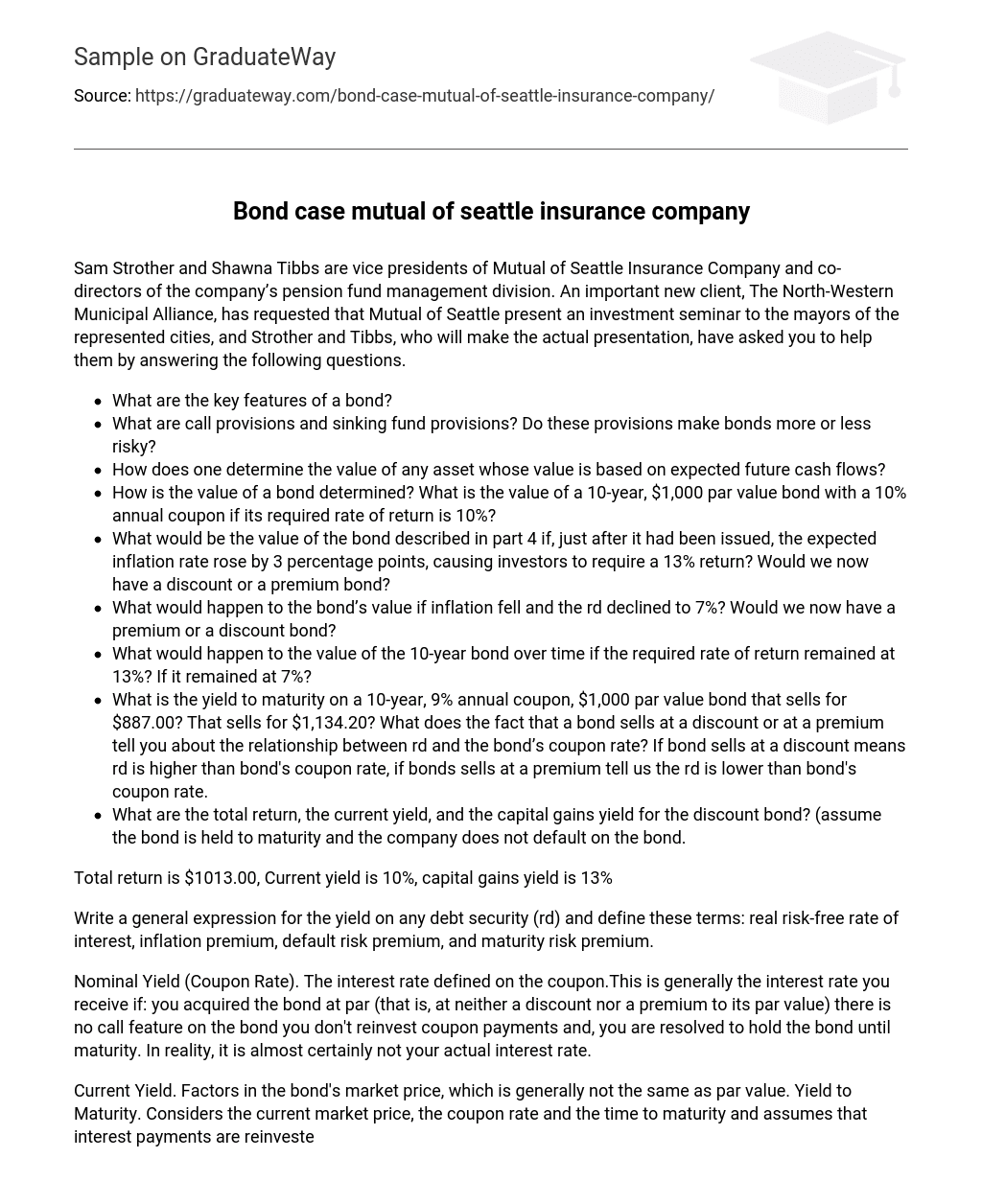Sam Strother and Shawna Tibbs are vice presidents of Mutual of Seattle Insurance Company and co-directors of the company’s pension fund management division. An important new client, The North-Western Municipal Alliance, has requested that Mutual of Seattle present an investment seminar to the mayors of the represented cities, and Strother and Tibbs, who will make the actual presentation, have asked you to help them by answering the following questions.
- What are the key features of a bond?
- What are call provisions and sinking fund provisions? Do these provisions make bonds more or less risky?
- How does one determine the value of any asset whose value is based on expected future cash flows?
- How is the value of a bond determined? What is the value of a 10-year, $1,000 par value bond with a 10% annual coupon if its required rate of return is 10%?
- What would be the value of the bond described in part 4 if, just after it had been issued, the expected inflation rate rose by 3 percentage points, causing investors to require a 13% return? Would we now have a discount or a premium bond?
- What would happen to the bond’s value if inflation fell and the rd declined to 7%? Would we now have a premium or a discount bond?
- What would happen to the value of the 10-year bond over time if the required rate of return remained at 13%? If it remained at 7%?
- What is the yield to maturity on a 10-year, 9% annual coupon, $1,000 par value bond that sells for $887.00? That sells for $1,134.20? What does the fact that a bond sells at a discount or at a premium tell you about the relationship between rd and the bond’s coupon rate? If bond sells at a discount means rd is higher than bond’s coupon rate, if bonds sells at a premium tell us the rd is lower than bond’s coupon rate.
- What are the total return, the current yield, and the capital gains yield for the discount bond? (assume the bond is held to maturity and the company does not default on the bond.
Total return is $1013.00, Current yield is 10%, capital gains yield is 13%
Write a general expression for the yield on any debt security (rd) and define these terms: real risk-free rate of interest, inflation premium, default risk premium, and maturity risk premium.
Nominal Yield (Coupon Rate). The interest rate defined on the coupon.This is generally the interest rate you receive if: you acquired the bond at par (that is, at neither a discount nor a premium to its par value) there is no call feature on the bond you don’t reinvest coupon payments and, you are resolved to hold the bond until maturity. In reality, it is almost certainly not your actual interest rate.
Current Yield. Factors in the bond’s market price, which is generally not the same as par value. Yield to Maturity. Considers the current market price, the coupon rate and the time to maturity and assumes that interest payments are reinvested at the bond’s coupon rate.
This is the most accurate, and most widely quoted, measure of return on a bond. Risk free return the theoretical rate of return of an investment with zero risk. The risk-free rate represents the interest an investor would expect from an absolutely risk-free investment over a specified period of time. Inflation premium the higher return that investors demand in exchange for investing in a long-term security where inflation has a greater potential to reduce the real return.
The inflation premium is the reason that most yield curves trend upward. Thus, a bond with a maturity of 30 years almost always has a higher coupon rate than one with a maturity of 30 days. Investors expect to make a larger nominal return in part to compensate them for the lower real return that is almost inevitable because of the nature of inflation The additional amount a borrower must pay to compensate the lender for assuming default risk. A default premium is generally paid by all companies or borrowers indirectly, through the rate at which they must repay their obligation.
A maturity risk premium is essentially the extra amount you can expect to earn on an investment by tying up your money in it for a longer period of time. For instance, the additional revenue you could get from a 10-year bond versus a 1-year bond would have a certain level of maturity risk premium. Define the nominal risk-free rate. What security can be used as an estimate of rRF The nominal risk-free rate = real risk-free rate + expected inflation.
10 year treasury bonds. What is interest rate (or price) risk? Which bond has more interest rate risk: an annual payment 1-year bond or a 10-year bond? Why? The risk that an investment’s value will change due to a change in the absolute level of interest rates, in the spread between two rates, in the shape of the yield curve or in any other interest rate relationship. Such changes usually affect securities inversely and can be reduced by diversifying (investing in fixed-income securities with different durations) or hedging (e.g. through an interest rate swap). 10-year has more interest rate risk, because the inflation rate is more like to increase, and the nominal interest rate will go down. What is reinvestment rate risk? Which has more reinvestment rate risk: a 1-year bond or a 10-year bond? The risk that future coupons from a bond will not be reinvested at the prevailing interest rate when the bond was initially purchased. Reinvestment risk is more likely when interest rates are declining.
Reinvestment risk affects the yield-to-maturity of a bond, which is calculated on the premise that all future coupon payments will be reinvested at the interest rate in effect when the bond was first purchased. The 10-year bond has more reinvestment risk.





